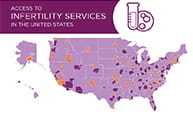
3/14/2018
PITTSBURGH, March 14, 2017 – New research from the University of Pittsburgh shows that nearly 40 percent of reproductive-aged women in the United States—approximately 25 million—have limited or no nearby access to assisted reproductive technology (ART) clinics, which provides services that are vital to many women aiming to become pregnant. Results of the study were published today in Fertility & Sterility.
While basic infertility evaluations and ovulation induction treatments can be performed by a woman’s obstetrician/gynecologist, advanced procedures such as in-vitro fertilization are provided only by more specialized providers in ART clinics. Study authors John Harris, M.D., M.Sc., and Marie Menke, M.D., M.P.H., both assistant professors of obstetrics, gynecology and reproductive sciences at Pitt’s School of Medicine and Magee-Womens Hospital of UPMC, together with co-authors from the University of Michigan, used federal data on infertility clinics and where women live to evaluate/assess women’s access to infertility care in the U.S.
Using data from the Centers for Disease Control and Prevention to locate 510 ART clinics in the United States and population data from the 2010 U.S. Census, the research team determined that 18.2 million women 20 to 49 years old—about 29 percent of that population—live in metropolitan areas with no ART clinics. Another 6.8 million women - or nearly 11 percent of the 20 to 49 year old population - live in areas with only a single ART clinic, and are without choice of a provider. The remaining 60 percent of the population, or 38.1 million women, live in census regions with multiple ART clinics, allowing them to seek ART services from a provider of their choice.
“Infertility is by itself a difficult issue for couples to face emotionally and financially,” said Harris. “Based on geography, many couples who are trying to start families may have only one clinic nearby where they seek these services, and many women with infertility do not have any nearby access to these services at all, adding additional anxiety during an already stressful time of life.”
The findings from this study raise additional questions about access to ART services that warrant further consideration and research. It is not known how far patients would be willing to travel for these services, or if the U.S. Census metropolitan areas used in the study accurately reflect where patients would consider seeking treatment. It also is not known how much time and money patients are willing to invest into reproductive services, and how these barriers interact with other demographic disparities, including race, socioeconomic status and age.
Investigative support for this study was provided by the National Institute of Child Health and Human Development, the Robert Wood Johnson Foundation and the U.S. Department of Veterans Affairs.
Click image to view infographic.

















